A Day in the Life of a Geomorphologist – Primary School Outreach Day hosted by Cardiff University
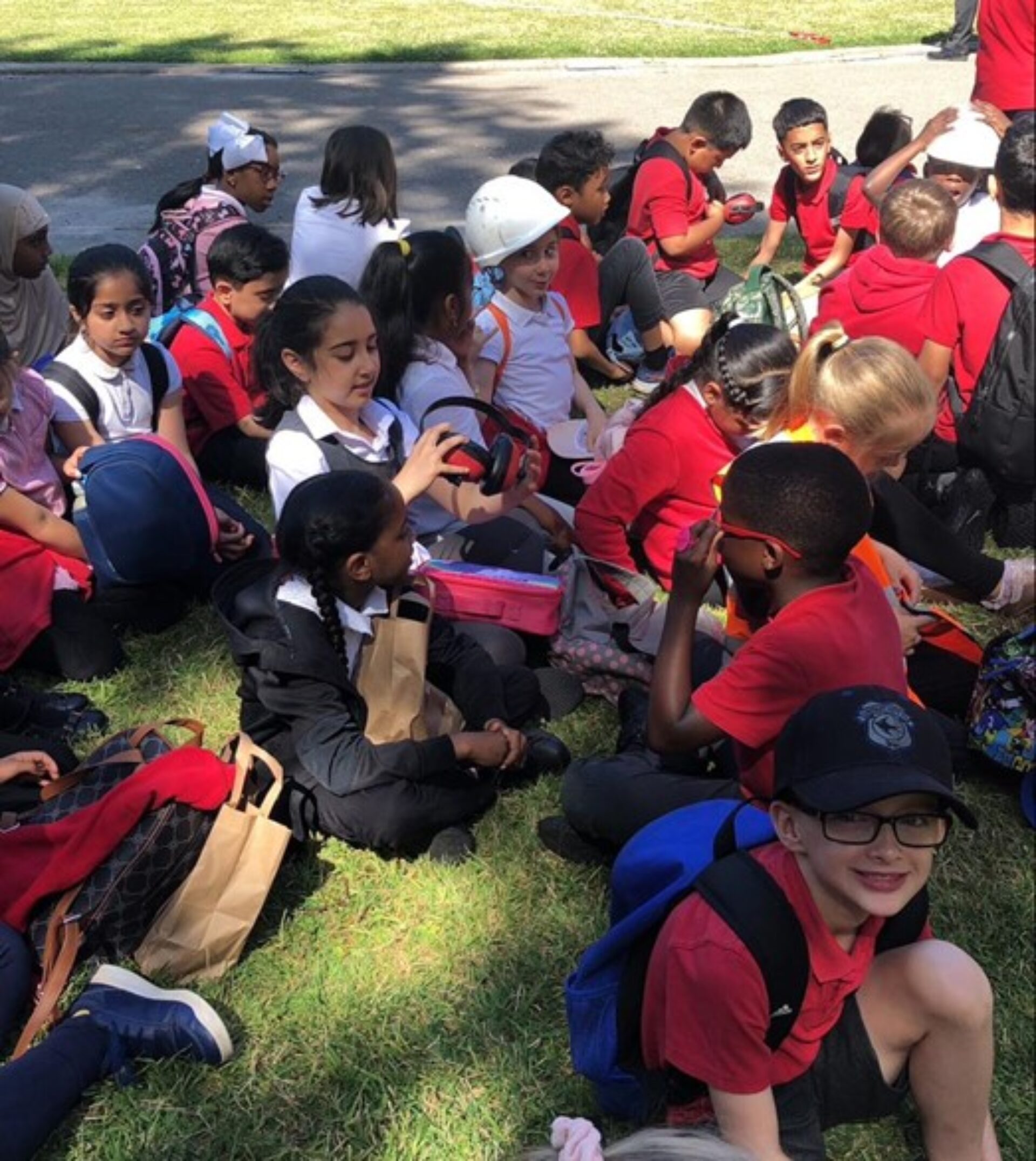
Dr Thomas Lawrence from Cardiff University reflects on an education and outreach activity funded by the BSG’s Education and Outreach Grant.
The Concept
July in a primary school means fun, and educational, trips away from the usual surroundings, and that was no different for the pupils and staff of Severn Primary in Cardiff . The idea was simple, invite the year 3 cohort of a local school to visit Cardiff University and experience a day in the life of a Geomorphologist. The reality provided a day full of inquisitive minds, fun (sometimes messy!) activities, and a sense that future Geomorphology careers had been defined and inspired in equal measure. The School of Earth and Environmental Sciences (EARTH) at Cardiff University had opened itself up to a new locally sourced set of 2032-33 undergraduates!
Who was Involved?
Severn Primary School is based in the inner-city Canton district, one of the most ethnically diverse and most Welsh-speaking districts of central Cardiff. Despite the relative lack of access to typical geomorphological features, the pupils bear a distinct enthusiasm and curiosity for the natural world. Through school topics from Mount Vesuvius to Mary Anning’s curiosities, the children have garnered a real interest in learning about Earth and Geographical Sciences.
Cardiff University has a record of engagement in outreach opportunities involving local groups, and a partnership with Severn Primary offered an exciting opportunity to invite such an inquisitive party onto ‘home turf’. A variety of staff from EARTH were keen to offer their own unique perspective of what it’s like to pursue a career in Earth and Geographical Sciences. A selection of staff expertise included seismic exploration, fluvial geomorphology, glacial geomorphology, geochronology, environmental geoscience, electron microscopy & volcanology.
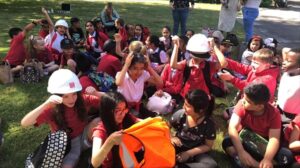
Field and Lab Activities
Seismic refraction
The day began with a field-based exercise on the Museum Avenue Lawn, where the pupils were introduced to seismic exploration via sub-surface refraction. The live printouts of refraction scanning allowed the pupils to see and explore the ground beneath their feet, an experience that inspired a wave of fascinating discussions. The pupils loved donning the uniform of the field geologist, with hard hats and high-vis vests scrambling through the crowd. We then moved into the labs, where a selection of practical activities was laid out for the students and demonstrated by a variety of EARTH staff.
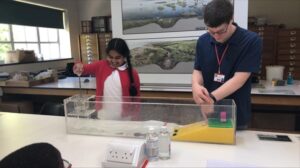
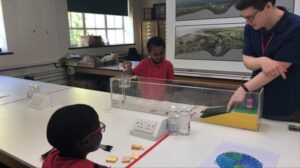
Saltmarshes and coastal flooding
A stroll along the coastline of south Wales often involves a variety of geomorphological features, from sheer cliff faces exposing millions of years of geological history, through to ria systems and saltmarshes, drowned in saline waters. Saltmarshes, their ecological significance, and influence in coastal flooding strategy, were the focus of the first activity for the pupils. A simple but effective proxy for a coastal wave flooding event, the wave box including a plunger and Lego settlement offered an ideal opportunity for the pupils to get hands-on. By creating a wave that flooded, or even demolished, the Lego settlement, it was clear how devastating coastal flooding can be. But hold on, the installation of a saltmarsh barrier dissipated the wave energy, allowing the houses to escape high and dry with perhaps a lap of water against the door acting as the biggest impact of the wave.
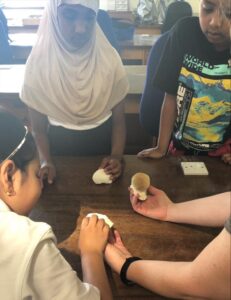
Coral reef health
The next stop was in deeper (and warmer!) waters, where coral health became the focus. A series of 3D coral models were brought out so the pupils could first get an idea for the intricate and beautiful structures that these organisms form.
Then came the threat to coral health, heat-reactive models changing in the blink of an eye, bleaching the colourful corals, and CO2 acidification demonstrated through breath, revealed how delicate reef systems can be. The algae that give coral its distinctive hue damaged so readily by environmental changes, a stark reminder of our effect on the natural systems of the planet.
Corals losing colour through the addition of hot water, and pH indicator showing acidification through breath CO2 gave a stunning visual reminder of how easily corals can be influenced by their surroundings.
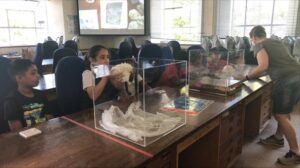
Rock and crystal structures
From colourful corals to vibrant mineralogy, the pupils crossed the divide to geology and were treated to a fascinating journey through the micro-scale detail of rocks and crystals. Through the popularity of Fortnite, obsidian has become a household name for young people, a level of fame for the volcanic glass that it perhaps deserved but never previously achieved.
The pupils were also familiar with the classifications of rocks, and particularly fossil-bearing limestones, as they had so keenly researched Mary Anning and her wonderful curiosities for a topic earlier in the year. But now they could see these from a different, rather more delicate, perspective, as they were taken through the world of thin-sections and the associated brightly coloured minerals and strange fossils contained within. Oolitic limestone prompted perhaps the most captivating period of this section, as the “egg stone” provided a new perspective on this classic rock.
On the thin-section big screen, even the smallest of features can engage an entire group.
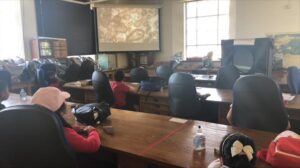
Topographic sandbox
Finally, we’re brought right back out to the landform scale, with the topographic sandbox again giving the pupils an opportunity to get hands on with some geomorphology, a sandy opportunity they did not ignore!
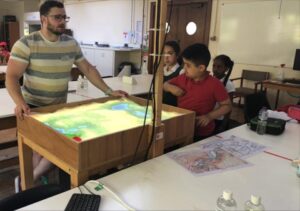
Whether the contours of the projected map were directing rainwater or lava flows, the pupils were keen to get involved in orogeny and dam building in equal measure.
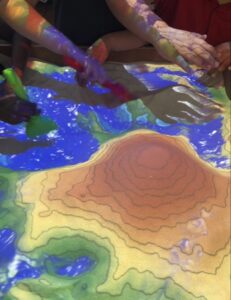
This rotation also provided some time for the pupils to get familiar with some fossil samples, a side-track that they were extremely keen on, to replicate their fossil hunting heroes.
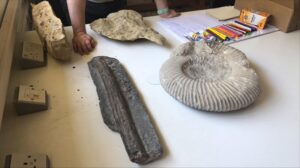
Pupil Posters
Once the activities ended and everyone had some well-earned lunch, the pupils were tasked with making a poster that depicted their favourite activity from the day. A selection of these is included below, with some highly variable reasons for finding a favourite!
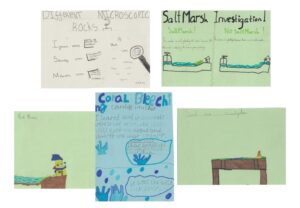
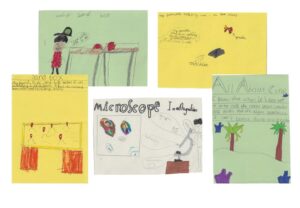
Staff Feedback
In addition to the favourite activity posters from the pupils, we sought further feedback from the Severn Primary staff about what they felt the pupils benefitted from the most, and where additional understanding was gained.
The staff commented that the day overall was a very valuable experience for the pupils, as geography, geomorphology and geology are not explicitly taught as distinct subjects at the primary school level. This meant that the pupils were generally unaware of earth and geographical sciences as a distinct interest and potential career path. Numerous pupils expressed an interest in pursuing earth and environmental sciences as a school subject or career path after the event.
More specifically, the pupils generally learned new content from several of the activities. The categorisation of obsidian as a volcanic glass formed new knowledge for several pupils and school staff, as well as the difference between mineral appearance in rock and thin-section formats. The saltmarsh activity forged new knowledge in the realm of their role in coastal defence strategy and managed realignment activities. Additionally, many of the visitors expressed that they gained substantial knowledge of coral health and the associated environmental impacts. Statistically, most of the pupils picked the coral reef and saltmarsh activities as their favourite.
~ Edited by Adam Hartley, 27th July 2024.

